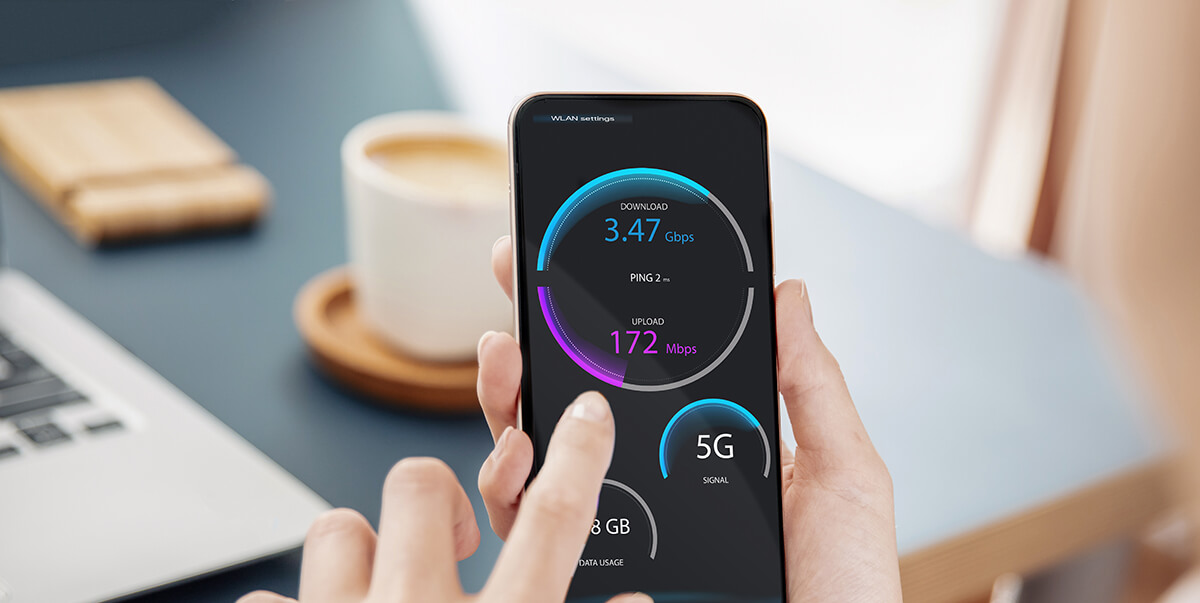

















To find out if you can get fibre and full fibre where you live, enter your postcode and address and we'll tell you what's available in your area.
Enter your full postcode and select your address.
We'll instantly check your area for fibre providers.
Compare the latest fibre broadband deals and offers.

To some, choosing a new fibre broadband deal can be as simple as using the comparison tools on this page and selecting something they like the look of. For others, the plethora of speeds available, differing contract lengths, varied routers, extras and add-ons, bundling options, and indeed just which provider is likely to provide them the best service can be a little overwhelming.
Here then, step-by-step, we are going to take you through exactly what you need to consider when choosing a new fibre deal, starting with what's available to you, followed by how to choose the most suitable provider, how to choose the right speed, and finally how to choose the right package.

Preceding every other choice you'll need to make to select the right deal is knowing what you can actually get. For that, all you really need to do is enter your postcode to be shown all of the deals available at your address. But with that done, what does your list comprise of?
Let's start with a non-technical explanation of the two types of widely available fibre broadband.
Standard 'superfast' fibre – Up until a couple of years ago, fibre broadband was of one type, what is now called 'Standard Fibre' and often referred to by providers as 'superfast fibre' (or FTTC by the broadband nerds). This type of fibre is available to over 99% of households, and has historically been offered at two speeds: Around 35Mbps and around 63Mbps – these numbers vary up and down slightly depending on the provider.
Full Fibre – This is the newest fibre technology, and is capable of speeds many times that of standard fibre. Providers would ideally like every customer on Full Fibre, which is why if you can get it they tend not to show you that standard fibre is even available on their own websites. It's not only faster, but more reliable, and since you tend to get better speeds for the same money or less with Full Fibre, our advice is also that if you can get Full Fibre, you should.
Here are the two types of fibre available compared side-by-side for easy reference:
| Feature | Standard Fibre (FTTC) | Full Fibre (FTTP) |
|---|---|---|
| Speed | 30-70Mbps | 100Mbps-2Gbps |
| Reliability | Good | High |
| Availability | 96% | 62% |
| Price range | £22-£35/month | £22-£84/month |
ADSL: It's worth mentioning briefly there are a handful of households dotted up and down the UK that can't get any sort of fibre broadband. If you're unlucky enough to be one of them you could be lumbered with ADSL – the creaking and ancient tech used since the early 2000s and capable of around 10-11Mbps. The households in this situation tend to be rural and remote.
Virgin Media: For the remainder of this walkthrough, we'll be treating Virgin Media as Full Fibre, since the speeds it offers are comparable. However, that's not technically true. Virgin Media has its own network which runs on a technology that's neither Full Fibre nor Standard Fibre – it's a bit of both. It has the advantage of matching the speeds of Full Fibre, but cannot match the low latency numbers proper Full Fibre can manage – something that's only important to competitive gamers.

"What type of fibre broadband to get has become an easy choice. If you can get Full Fibre, you should definitely get it. It won't cost you any more and it offers superior speeds, reliability and latency. If on the other hand you can't yet get Full Fibre, providers are now mostly offering just one Standard Fibre speed (around 61-63Mbps)."
Dan Howdle, Broadband and mobile expert
Our advice is if you're lucky enough to be able to get Full Fibre, you should. Here's why:
According to the latest Ofcom data, the average speed from fibre-to-the-cabinet (FTTC) connections in the UK is 55.57Mbps, while the average of full-fibre connections is 149.2Mbps. Bear in mind though that these measurements tend to be more representative of the speed people choose on average than the potential performance of each of these technologies.

This is important because it's absolutely possible both to overspend on more speed than you can possibly make any good use of, or to take out a package that's going to cause your household problems when everyone in it wants to game, stream, and browse all at the same time. So how do you get that right?
Well, first off, our advice in 2024 is to aim for at least 20Mbps per broadband user in your household. House of four? You'll need at least 80Mbps, or as close to that as you can get. This gets a little more complex when you have gamers and avid streamers in the household. For gamers specifically, we recommend at least 40Mbps per person. That should give you a figure to start from, before taking into account further considerations. Here's a snapshot to clarify:
| Broadband users | Type of broadband | Speeds |
|---|---|---|
| 1-2 people | ADSL or Fibre | 10-60Mbps |
| 3-4 people | Fibre or Full Fibre | 100-300Mbps |
| 5+ people | Full Fibre | 150-500Mbps |
| Gamers or streamers | Full Fibre | 300-1Gbps or more |
For a more in-depth look at broadband speeds and really getting into the nitty-gritty of what you'll need and why you'll need it, you can read our full guide.

"Estimating the right speed for your household is more art than science, because most times of the day a lot of the speed you're paying for is going to sit redundant. What you should be 'budgeting' for in terms of speed is instead what your maximum usage is going to look like at the busiest times of day."
"The thing that catches most people out is not properly accounting for gamers. Games these days don't require much speed to play online, however, three of the most popular titles this year clock in at nearly 200GB each. We cannot stress what a huge download that is, and unless you're restricting speed to certain devices via your router (some can do this, others can't), it's going to slow the entire household to a painful snail's pace."
Dan Howdle, Broadband and mobile expert
Finally, the following table may be helpful is assessing the needs for your household, showing the 'bandwidth' (how much speed) requirements of common tasks.
| Activity | Speed Required |
|---|---|
| Browsing social media | 1Mbps |
| Browsing the internet – reading content, online shopping, etc. | 2Mbps |
| Streaming Netflix in SD | 3Mbps |
| Streaming Netflix in HD | 5Mbps |
| Streaming Netflix in 4K | 25Mbps |
| Playing games online | 3-6Mbps |
| Downloading games | The faster the better |
| Streaming games | 35Mbps |
So, you've narrowed down both what you can get, and from that decided which speed would best suit your household. Problem is, you've now realised that just about every provider you can get at your address offers that speed. So how do you choose between them? In this section, we're going to take a look at what you should consider when choosing a provider, and finish up by showing you the major providers side-by-side in terms of the factors that matter the most.
Installation times are universal across all providers, all stating roughly two weeks. Sometimes it's a bit faster, sometimes a bit slower, but you'll always be given a date when you sign up. In terms of the work that needs doing, it will fall into one of three categories depending on the lines you have (or not) already running into your home.
You'll notice that pricing can vary wildly, even for the same broadband speeds, among different providers. Each provider sets its own price point, and more often than not that's related to their brand (BT is notoriously expensive 'because it's BT', for example). So it's a good idea to set your own budget. Rarely are more expensive providers worth the extra money, and tend to rely on your awareness and comfort with the brand more than making any real effort to offer additional value.
Not long ago, providers would offer either 12-month or 18-month contracts, with the odd few offering one-month rolling contracts at a slightly inflated cost. Well, now there are very few 12-month contracts out there, with most plumping for 24 months, and a handful sticking to offering 18 months. Longer contracts are less ideal in our opinion since they tie you in for longer with very little in terms of compensatory benefit. Shorter contracts are better, but that does narrow your choices considerably.
See Short contract broadband and Fixed priced broadband for the latest deals.
Providers like Plusnet, Rebel, and Vodafone Broadband offer excellent equipment and customer service, and are great choices if you never plan to expand your subscription with a TV package or even a mobile SIM. But bundling services is an excellent way to save money, provided you want TV, a home phone or a mobile SIM (or all of the above). When choosing a provider it's worth considering what you might like to bundle in either from day one, or further down the line.
To compare and check availability, see our Broadband and TV comparison for more details.
All broadband providers offer a home phone, but increasingly households don't find themselves in need of one. If yours does, take your pick of providers. The main quirks to watch out for are that landlines tend not to be offered as standard on Full Fibre packages, but do come with Standard Fibre packages, with the exception of Sky Broadband, which comes with a pay-as-you-talk landline no matter which package you select. For the others you'll need to add in a calling package at extra cost when you sign up.
Often an afterthought, customer service is completely unimportant. Until something goes wrong. At that point it is suddenly promoted to the most important aspect of a provider. Ofcom puts out annual figures on number of complaints, how complaints are handled, and customer satisfaction (shown in the table below). These figures are far more reliable than independent review sources like Trustpilot, because review sites have a heavy bias towards those who have a reason to complain.
The range of routers offered both by differing providers and indeed different packages within individual providers is, how shall we put it? Dazzling? There are a lot of routers out there. Firstly, how do you know which router you're going to get? And secondly, how are you meant to assess whether or not that router is any good? This is not the place to go down that rabbit-hole. It's too deep, and too technical. However, there are some broad pointers that should help you along:
| Provider | Speed range | Customer service satisfaction | Extra features | Contract length |
|---|---|---|---|---|
| BT Broadband | 10Mbps to 900Mbps | 83% | Complete Wi-Fi, Digital Voice, Halo for extra features | 24 months |
| Plusnet | 66Mbps to 910Mbps | 89% | Smart wireless, good range, family-friendly features | 24 months |
| Sky Broadband | 61Mbps to 900Mbps | 82% | Wi-Fi guarantee, Sky Shield security, parental controls | 24 months |
| TalkTalk | 67Mbps to 900Mbps | 78% | HomeSafe security, future-proof Wi-Fi 6 options | 18 months |
| Virgin Media | 54Mbps to 2Gbps | 81% | Intelligent Wi-Fi, security features, child-friendly filters | 18 months |
| Vodafone Broadband | 35Mbps to 1.6Gbps | 83% | Pro Broadband with mesh extenders, 4G backup | 24 months |
Customer satisfaction source: Ofcom

"When all is said and done, even if you don't get your choice of deal exactly right, you will be in the right ballpark. Most providers are only too happy to upgrade your speed and services should you need that further down the line. Just bear in mind that wile it's easy to upgrade, you can't downgrade, and that upgrading often requires signing a brand new contract and therefore beginning your contract period all over again."
Dan Howdle, Broadband and mobile expert
Finally, there are a few other factors you may wish to consider when choosing a new fibre deal. These are universal. You should:
Many providers offer enticing deals for new customers, such as discounted rates for the first 6 to 12 months, free setup, gift cards, reward cards or bill credit. For example, BT often offers reward cards for new sign-ups. Always check for these deals as they can reduce the overall cost of the package, or simply make it more worth your while.
Introductory prices can be tempting, but be aware that most providers raise prices after your contract period ends. For instance, Virgin Media’s low starting rates can jump significantly when the contract renews, so it’s crucial to plan ahead or negotiate a better deal before the price increase kicks in.
Some providers may advertise low prices but include hidden charges like router delivery fees or setup costs. Just remember, we don't hide costs on Cable.co.uk – up-front and one-off costs are always shown in our listings.
Broadband packages can come with extras that add value to your service, such as free security software, streaming service trials and so on. Providers like Sky and Virgin Media often include free access to Netflix if you opt for a bundle, for example.
If you already have other services with a provider, such as a mobile plan, you might be eligible for exclusive broadband discounts, or vice-versa. Sky Mobile, for example, often offers double data if you are with Sky Broadband, while EE offers money off.
We price check the best broadband deals from the top providers every day.
See all broadband providersOur expert advisors have access to special offers and can create a personalised package just for you. Give us a call!
Call 0333 210 1160We're available from 8am-8pm, Monday to Sunday
The cheapest fibre broadband packages start from £17.99 per month. Our best tip is to search for deals but they come and go, so be sure to keep your eyes open.
Full Fibre broadband isn't as widely available as fibre broadband – only available to around 62% of households, versus 99.8% of households for fibre. If you can get Full Fibre though, we strongly advise you do, since there is no cost advantage to opting for a slower fibre deal.
Virgin Media now provides up to 2Gbps (Gig2) to around a million UK households, but that makes up only around 3% of homes. The fastest widely available broadband is offered by EE Broadband and Vodafone Broadband, both of which offer 1.6Gbps packages to around 62% of UK homes.
Use our free broadband speed checker. You can check you're getting the speed you're paying for, but for an accurate reading, make sure you do so vai a cable to your computer as Wi-Fi speeds have their own limits.
Yes, it’s possible to get a fibre connection without a landline. Full Fibre tends to be supplied without a landline as standard now (except in the case of Sky), and increasingly, you'll need to ask your provider for a landline if you still need one.
Openreach, the network on which BT, Sky, TalkTalk and all the others operate (not Virgin Media, though), is in the process of rolling out Full Fibre across the UK. Full Fibre is currently available to around 62% of homes in the UK.